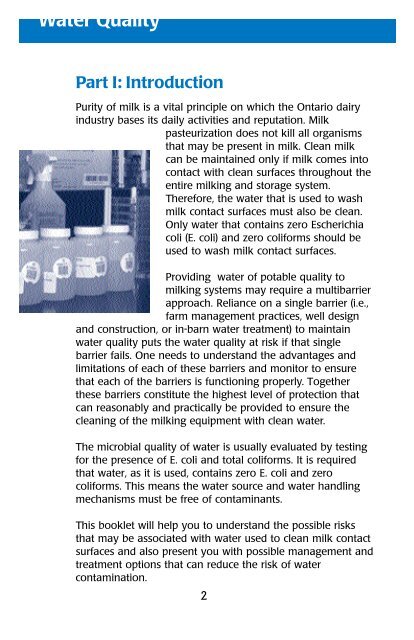Water Used To Wash Milk Contact Surfaces - Dairy Farmers of Ontario
Water Used To Wash Milk Contact Surfaces - Dairy Farmers of Ontario
Water Used To Wash Milk Contact Surfaces - Dairy Farmers of Ontario
You also want an ePaper? Increase the reach of your titles
YUMPU automatically turns print PDFs into web optimized ePapers that Google loves.
<strong>Water</strong> Quality<br />
Part I: Introduction<br />
Purity <strong>of</strong> milk is a vital principle on which the <strong>Ontario</strong> dairy<br />
industry bases its daily activities and reputation. <strong>Milk</strong><br />
pasteurization does not kill all organisms<br />
that may be present in milk. Clean milk<br />
can be maintained only if milk comes into<br />
contact with clean surfaces throughout the<br />
entire milking and storage system.<br />
Therefore, the water that is used to wash<br />
milk contact surfaces must also be clean.<br />
Only water that contains zero Escherichia<br />
coli (E. coli) and zero coliforms should be<br />
used to wash milk contact surfaces.<br />
Providing water <strong>of</strong> potable quality to<br />
milking systems may require a multibarrier<br />
approach. Reliance on a single barrier (i.e.,<br />
farm management practices, well design<br />
and construction, or in-barn water treatment) to maintain<br />
water quality puts the water quality at risk if that single<br />
barrier fails. One needs to understand the advantages and<br />
limitations <strong>of</strong> each <strong>of</strong> these barriers and monitor to ensure<br />
that each <strong>of</strong> the barriers is functioning properly. <strong>To</strong>gether<br />
these barriers constitute the highest level <strong>of</strong> protection that<br />
can reasonably and practically be provided to ensure the<br />
cleaning <strong>of</strong> the milking equipment with clean water.<br />
The microbial quality <strong>of</strong> water is usually evaluated by testing<br />
for the presence <strong>of</strong> E. coli and total coliforms. It is required<br />
that water, as it is used, contains zero E. coli and zero<br />
coliforms. This means the water source and water handling<br />
mechanisms must be free <strong>of</strong> contaminants.<br />
This booklet will help you to understand the possible risks<br />
that may be associated with water used to clean milk contact<br />
surfaces and also present you with possible management and<br />
treatment options that can reduce the risk <strong>of</strong> water<br />
contamination.<br />
2
















